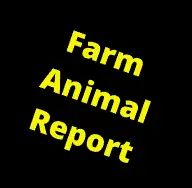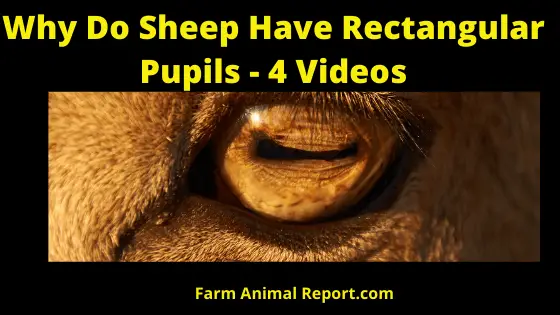What Shape is the Sheep’s Pupils?
Why Do Sheep Eyes Have Rectangular Pupils – Sheep are herbivores (prey animals ), grazing animals, and need to be able to protect themselves when a predator comes along. A broad line of sight, aided by wide, rectangular-shaped pupils, allows them to see danger approaching from their peripheral vision. Their eye ( Sheep Eyes) s also have a remarkable ability to “rotate in the head to maintain parallelism with the ground. What Shape is the Sheep’s Pupils?
This means that when goats bend their head down to eat grazing animals, their eyes stay level with the horizon, allowing them an even better view of encroaching danger.
Animals with Horizontally Elongated Pupils ( pupil shapes )
Horizontal pupils are one of the many things that make goats unique, and in our opinion, a reason to love and protect them all the more! Sheep are not the only animals with rectangular pupils, Goats, cattle, deer, llamas, and many other grazing animals have similarly shaped pupils.
Check Our Amazons Resources on Sheep
Sheep Eyes – Rectangular Pupils Give Panoramic Vision – Color
They may look odd ( horizontally elongated pupils ) but they have a very important function. These animals are generally considered prey animals, grazing animals, and they have an evolutionary survival need to be alert for signs of danger at all times. These large rectangular pupils give the animals panoramic vision, allowing them to survey the horizon for potential threats.
As many of these animals live in open fields, it also helps the eye to gather more light from the ground and less from the dazzling sky. Conversely, predatory animals have slit-shaped pupils to help focus a target and judge how far away prey is, helping them to stalk and pounce.
Sheep have a very large pupils, (horizontally elongated pupils) and the sheep pupil is differently shaped ( compare form) than the human pupil. The sheep pupil is somewhat rectangular in shape. And the eyeball is placed more to the side of the head, which gives them a wider field of vision.
Behavioral scientists believe that the placement and structure of the sheep’s eyes are due to nature’s designation of sheep as a prey species. Predator species, such as dogs and coyotes, have eyes placed toward the front of their head.
This narrows their total field of vision but it increases their binocular visual field. This gives the predators better depth perception and a more concentrated field of vision.
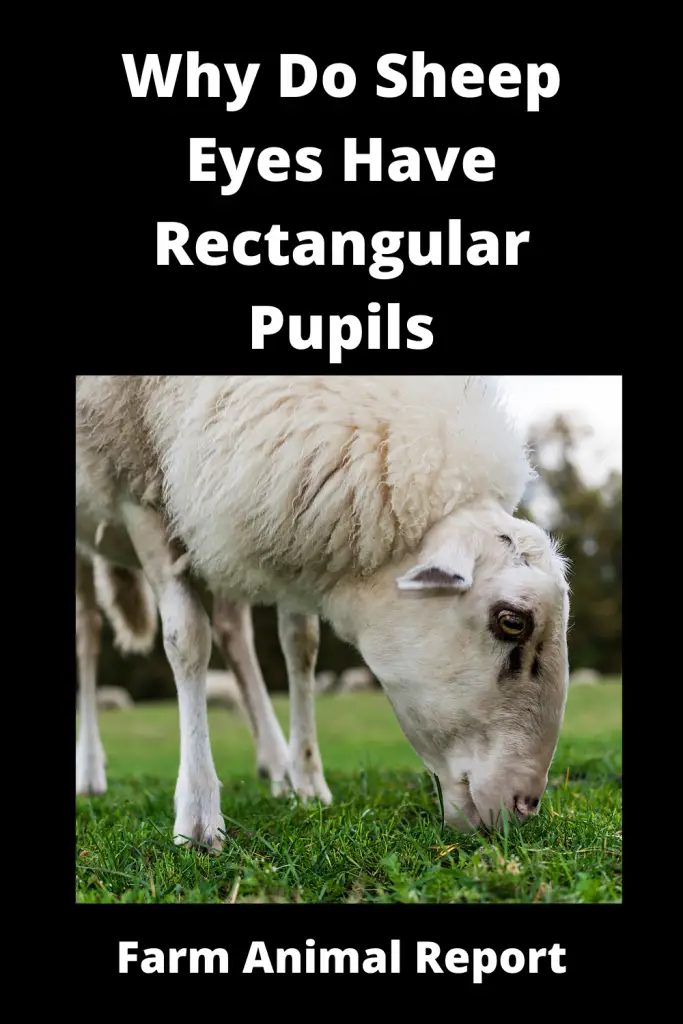
Prey species, like sheep and cattle, have a much wider visual field. With only a slight head movement, sheep can scan their entire surroundings. If there is a threat, the sheep are likely to perceive it and the behavioral response is generally to flee.
The shape of the pupil further enhances the ability of sheep to pick up movement. The rectangular shape provides a built-in wide-angle lens effect which is further enhanced by the placement of the visual receptors in the retina. The total effect is enhanced peripheral vision. It is speculated that a certain amount of vertical vision is sacrificed, i.e., sheep may not be able to easily observe objects that are overhead, such as a predator in a tree.
See Our Extensive Guide – 16 Ways to Make Money Sheep Farming
A similar phenomenon is noted in deer, hence the popularity of hunting from overhead stands by deer hunters. Do the sheep sacrifice visual acuity to obtain a wide visual field of vision? The answer to this question is not clear, but the current thought is that sheep’s vision (sheep eye) is relatively keen. Consider the advantages of good close-range vision for efficiently obtaining the best selection of pasture species.
Evidence to support this is obtained by comparing the number of cones and rods in sheep versus humans, and the difference is not substantial. What about color vision?
For many years it was believed that both cattle and sheep were color blind, but apparently this is not true.
Current evidence is that all common livestock (grazing animals) have the cones necessary for color vision. In addition, research with sheep trained to discriminate between colors has led investigators to conclude that sheep are not color blind. It is, however, likely that sheep’s color acuity is not equal to other species, such as humans.
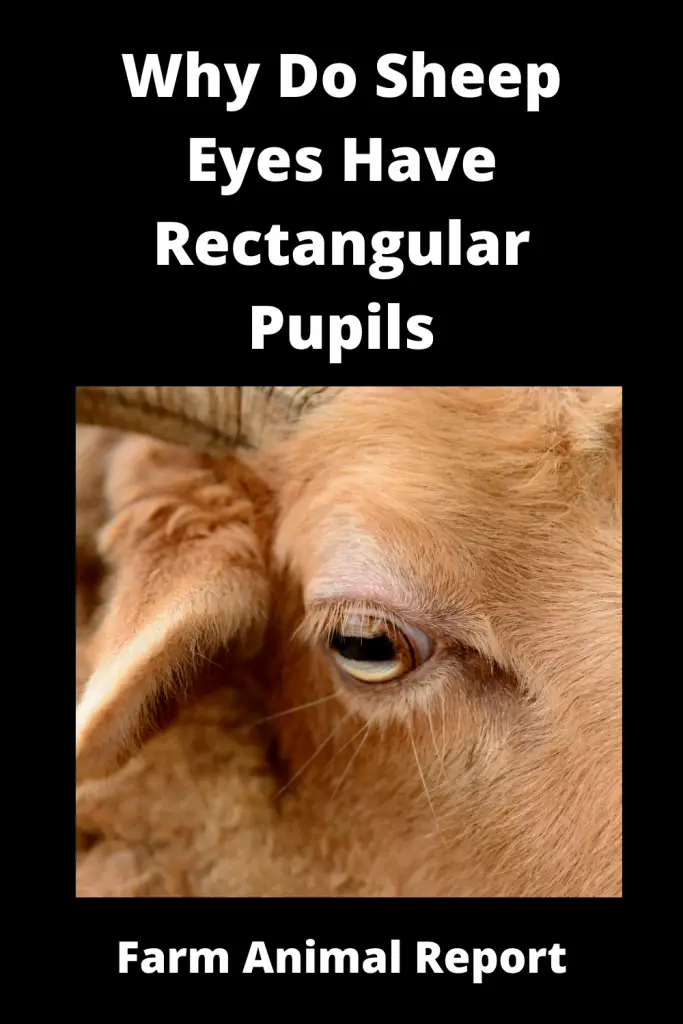
Sheep Eyes – Basic Image Structure and Function of the Eye
The basic eye is anything but basic. Instead, it is very complex, constantly adjusting to surroundings and to the amount of light it lets in. Though the intricate workings of an eye contain several components, the ones we’ll discuss today are the pupil and the iris. They Have horizontally elongated pupils.
The pupil (horizontal pupils) is the point at which light enters the eye and results in the mind conjuring an image.
The larger the pupil, the more sunlight shines through. The evolution of the pupil lies in the idea of “survival of the fitter”, better known as Darwin’s Theory. Differences in circumstances and in surroundings determine not only mundane physical characteristics but how we use our eyes as well.
The pupil is involuntarily controlled by the iris, which constricts and dilates in order to regulate the amount of light that enters the cornea.
The iris is the control center for light, controlling how much is let into the eye. When there is an abundance of light the iris adjusts by shrinking, allowing just enough light to be absorbed.
Under darker circumstances, however, the iris expands to allow maximum light to be absorbed. The function of the iris is a great proof of evolution by clearly defining which animals would survive better. Animals whose eyes could adapt to lighting variations could easily and under any circumstances avoid predators, and thus pass those genes on.
Caution : Graphic Sheep Eyes Dissection By Dr Professor Wilson
Variations in the structure of the Eyes (sheep eye)
Pupils ( horizontal pupils) also come in types, depending on the purpose they may hold for the animal ( especially grazing animals) that contains it. For example, a species of animals who spend a majority of time in the sun usually have sheep eyes with spherical pupils. Those who need to be active during all times of day and night are better equipped with pupils which can easily vary or adjust, such as rectangular eyes. Common variations include: image quality
Rectangular: Sheep, Goats, Octopuses, and Toads have these rectangular-shaped pupils (horizontally elongated pupils). Typically classified as prey, (prey animals) these animals need to have a defense both day and night. But they don’t have vertical slits due to their need to survey their surroundings more accurately.
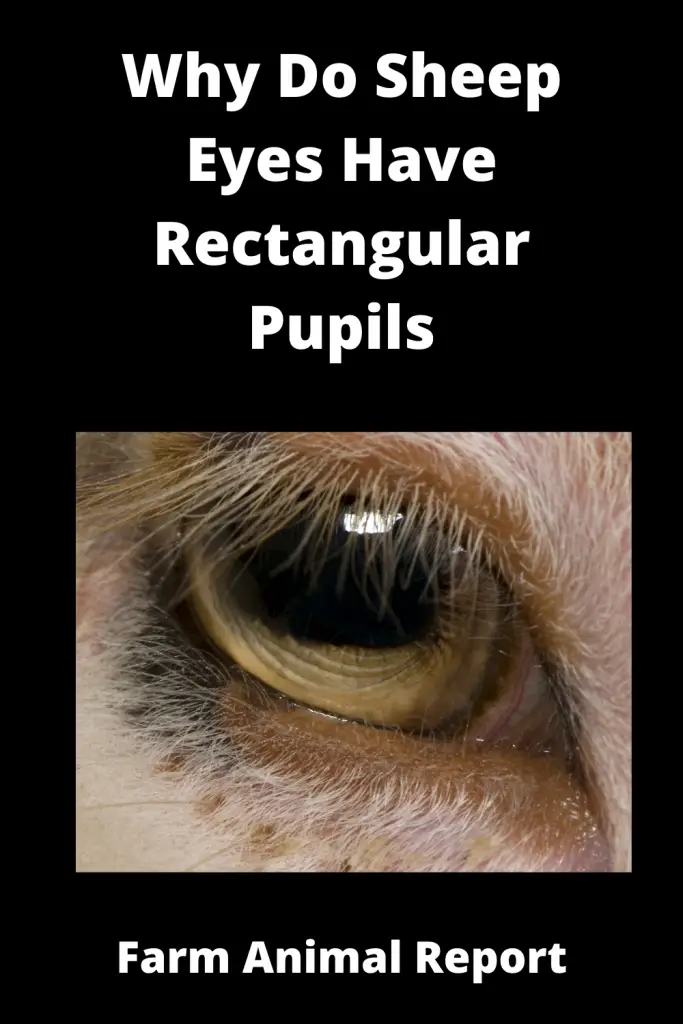
The narrower the pupil (horizontal pupils) in relation to the horizon, the greater the accuracy of depth perception is in the peripheral vision of the animal. The perception of depth must be considered with these animals who spend their time evading predators in rugged terrain.
Spherical: This is the typical pupil seen in the human species as well as in primates, canines, and the just of the animal kingdom. This type of pupil adapts well to the intensity of light during the day, though isn’t necessarily (image quality) proficient during nighttime outings. Useful in broad observations of carnivores and like predators.
Vertical Slit: Cats, many species of snakes, alligators and crocodiles possess these eyes. Although these types of pupils are a useful adaptation for nocturnal animals, the animals who usually have them are both active day AND night. Because of their exposure to daytime lights, this pupil allows protection of the retina in daylight glare.
Learn More – Sheeps Hearing
Characteristics of Sheep Eyes
Sheep have a very unique appearance. Some of the characteristics that make them stand out from other livestock is their long face and snout, along with their large eyes which are often described as wide-set or “bug-eyed” looking.
They appear rectangular in shape and their pupil is an oblong that can come in a variety of colors, including black or brown. The sclera (white part) often looks like it has a blue hue to it, which makes sense since the darker color of the iris and pupil blends into this area when you look at them up close.
The eyes of a sheep ( prey animals)are very large, even when compared to other domesticated animals. In fact, the size of their eyes allows them to see almost 360 degrees around themselves without moving their heads or necks.
This gives them an “all-seeing” quality and helps them better protect themselves from predators while out in the open fields during daylight hours.
Their eyes aren’t just used for seeing – they also help with balance and depth perception. This is why you will often see sheep bobbing their heads or twisting them as if they are trying to look behind themselves without turning around.
The position of the eyes on a sheep gives it an excellent peripheral vision, which can be very helpful when they are faced with a predator and need to see what is around them.
Characteristics of Goats Eyes
Goats have vertically-slit pupils. ____ Goats are generally active during the day but can be seen throughout the entire 24 hours of a day.
One characteristic that is visible in the eyes through time is their color change as they mature. This means that Baby Goats will not always maintain blue eyes and Adult goats’ eyes will not always maintain that golden color.
Sheep Farming for Wool Profitability Table
| Sheep | Lambs / 3 Per Yr | Space Required 20 Sq Feet - Each | Grazing Acres .3 / Sheep | Feed Required / Yr $100 | 15 Lbs Wool / Year | Average Price $ 10 / LB Wool | Total Revenue Possible |
|---|---|---|---|---|---|---|---|
| 1 | 3 | 60 sq ft | .9 acres | $ 300 | 45 lbs | $ 450 | $ 150 |
| 2 | 6 | 120 sq ft | 1.80 acres | $ 600 | 90 lbs | $ 900 | $ 300 |
| 5 | 15 | 300 sq ft | 4.5 acres | $ 1,500 | 225 lbs | $ 2,250 | $ 750 |
| 10 | 30 | 600 sq ft | 9 acres | $ 3,000 | 450 lbs | $ 4,500 | $ 1,500 |
| 20 | 60 | 1200 sq ft | 18 acres | $ 6,000 | 900 lbs | $ 9,000 | $ 3,000 |
| 30 | 90 | 2,700 sq ft | 27 acres | $ 9,000 | 1,350 lbs | $ 13,500 | $ 4,500 |
| 40 | 120 | 4800 sq ft | 36 acres | $ 12,000 | 1,800 lbs | $ 18,000 | $ 6,000 |
| 50 | 150 | 3,000 sq ft | 45 acres | $ 15,000 | 2,250 lbs | $ 22,500 | $ 7,500 |
| 100 | 300 | 6,000 sq ft | 90 acres | $ 30,000 | 4,500 lbs | $ 45,000 | $ 15,000 |
| 200 | 600 | 12,000 sq ft | 180 acres | $ 60,000 | 9,000 lbs | $ 90,000 | $ 30,000 |
Sheep can Produce 2 - 30 lbs of wool per year depending on Breed
Raw washed Wool Runs $ 6 - $ 14 using average $ 10
Feed 5 Months Buying Hay $ 100 rest Grazing
Please Check my Numbers
Sheep Farming for Milk Profitability Table
| Sheep | Lambs / 3 Per Yr | Space Required 20 Sq Feet - Each | Grazing Acres .3 / Sheep | Feed Required / Yr $100 | Wool $ 15 lb / Year | Average Price $ 10 / LB Wool | 90 Gallon/ Yr each ewe | Price $ 30 per Gallon | Total Wool Revenue Possible | Total Revenue Milk and Wool |
|---|---|---|---|---|---|---|---|---|---|---|
| 1 | 3 | 60 sq ft | .9 acres | $ 300 | 45 lbs | $ 450 | 270 | 8100 | $ 150 | 8,250 |
| 2 | 6 | 120 sq ft | 1.80 acres | $ 600 | 90 lbs | $ 900 | 540 | 16,200 | $ 300 | 16,500 |
| 5 | 15 | 300 sq ft | 4.5 acres | $ 1,500 | 225 lbs | $ 2,250 | 1350 | 40,500 | $ 750 | 41,250 |
| 10 | 30 | 600 sq ft | 9 acres | $ 3,000 | 450 lbs | $ 4,500 | 2700 | 81,000 | $ 1,500 | 82,500 |
| 20 | 60 | 1200 sq ft | 18 acres | $ 6,000 | 900 lbs | $ 9,000 | 5400 | 162,000 | $ 3,000 | 165,000 |
| 30 | 90 | 2,700 sq ft | 27 acres | $ 9,000 | 1,350 lbs | $ 13,500 | 8100 | 243,000 | $ 4,500 | 247,500 |
| 40 | 120 | 4800 sq ft | 36 acres | $ 12,000 | 1,800 lbs | $ 18,000 | 10,800 | 324,000 | $ 6,000 | 330,000 |
| 50 | 150 | 3,000 sq ft | 45 acres | $ 15,000 | 2,250 lbs | $ 22,500 | 13,500 | 405,000 | $ 7,500 | 412,500 |
| 100 | 300 | 6,000 sq ft | 90 acres | $ 30,000 | 4,500 lbs | $ 45,000 | 27,000 | 810,000 | $ 15,000 | 825,000 |
| 200 | 600 | 12,000 sq ft | 180 acres | $ 60,000 | 9,000 lbs | $ 90,000 | 54,000 | 1,620,000 | $ 30,000 | 1,650,000 |
Sheep can Produce 1/2 Gallon Milk per day / 180 Day Lactation
Raw Sheep Milk $9 - $25 per Quart - Used $ 30 per Gallon for Table
Feed 5 Months Buying Hay $ 100 rest Grazing
Please Check my Numbers
Sheep Associations 10 Breeds of Sheep
| Breeds of Sheep | Country Origin | Purpose of Breed | Use | Ewe Weight | Association For Info |
|---|---|---|---|---|---|
| Suffolk Sheep | Britian / Suffolk | Fast Growing | Meat | 250 - 350 Lbs | United Suffolk Sheep Association |
| Merino Sheep | Spain | Softest Wool | Wool | 100 - 200 Lbs | American and Delane Merino Sheep Association |
| Hampshire | Britain | Best Tasting Mutton | Wool / Meat | 200 Lbs | American Hampshire Sheep Association |
| Romney | England / Romney Marsh | Disease Resistance | Wool / Meat | 225 - 275 Lbs | American Romney Breeders Association |
| Lincoln Sheep | England | Produce Longest Fleece In World | Wool | 250 - 350 Lbs | National Lincoln Sheep Breeders Association |
| Dorper Sheep | South African | Fast Growing Meat | Meat | 230 Lbs | American Droper Sheep association |
| Turcana Sheep | Romainia | Adapted Alpine Pasture | Wool / Milk / Meat | 175 - 200 Lbs | ? |
| Rambouilette Sheep | France | Strong / Hearty / All Climates | Wool / Meat | 300 Lbs | American Rambouilette Sheep Breeders Association |
| Leicester Longwool | United Kingdom | Fast growing / Good Fleece | Wool | 200 Lbs | Leicester Longwool Sheep Breeders Association |
